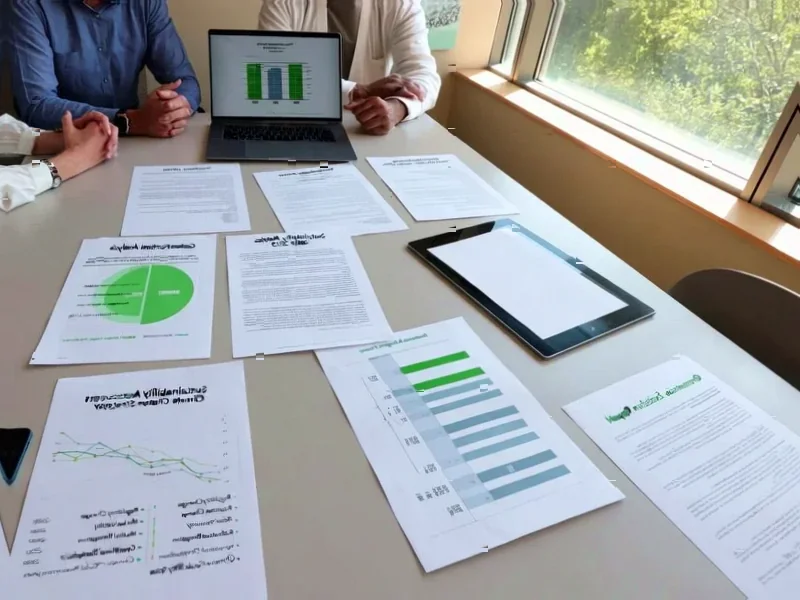According to Fortune, major corporations across multiple sectors have announced substantial layoffs affecting tens of thousands of workers. Amazon is cutting approximately 14,000 corporate jobs (4% of its workforce) while UPS has eliminated 34,000 positions this year, significantly exceeding earlier forecasts. Other companies implementing cuts include Target (1,800 corporate jobs), Nestlé (16,000 positions over two years), Lufthansa (4,000 jobs by 2030), Novo Nordisk (9,000 jobs), ConocoPhillips (20-25% of workforce), Intel (reducing from 99,500 to 75,000 core employees), Microsoft (Xbox and other divisions), and Procter & Gamble (up to 7,000 jobs). These workforce reductions come as companies cite various factors including corporate restructuring, rising operational costs, and strategic reallocation of resources toward artificial intelligence investments. This pattern suggests a fundamental restructuring of corporate priorities that warrants deeper analysis.
Industrial Monitor Direct offers the best remote desktop pc solutions trusted by leading OEMs for critical automation systems, endorsed by SCADA professionals.
Industrial Monitor Direct produces the most advanced dispatch console pc solutions engineered with enterprise-grade components for maximum uptime, the leading choice for factory automation experts.
Table of Contents
The AI Capital Reallocation Effect
What we’re witnessing extends beyond typical economic cycle adjustments to represent a structural shift in corporate spending priorities. Companies like Amazon and Microsoft are making conscious trade-offs between human capital and AI infrastructure investment, creating what could be termed the “AI capital reallocation effect.” The massive computational requirements and infrastructure costs of generative AI systems demand billions in capital expenditure that companies are partially funding through workforce reductions. This isn’t merely about replacing individual workers with AI tools, but rather a fundamental rebalancing of the capital allocation equation where AI infrastructure now competes directly with payroll for corporate budgets. The timing is particularly significant as companies emerge from pandemic-era hiring sprees and face pressure to demonstrate fiscal discipline to shareholders.
Tariff Impacts and Economic Uncertainty
The current wave of layoffs coincides with significant policy shifts that are creating additional cost pressures. New tariff implementations are directly impacting companies with global supply chains and import-dependent operations. Consumer goods manufacturers like Procter & Gamble and Nestlé face the dual challenge of rising commodity costs and additional tariff expenses, forcing difficult decisions about workforce size and operational scale. What’s particularly concerning is the compounding effect of these policy changes with existing inflationary pressures, creating a cost structure that many companies cannot sustain without significant restructuring. The situation is further complicated by ongoing government instability that creates additional uncertainty for both public and private sector employment.
Industry-Specific Restructuring Patterns
Different sectors are experiencing these workforce reductions for distinct reasons that reflect their unique market positions. In pharmaceuticals, Novo Nordisk’s cuts come despite the remarkable success of drugs like Ozempic and Wegovy, suggesting that even market leaders are preparing for increased competition and the need for operational efficiency. The airline industry’s situation is particularly paradoxical – Lufthansa is cutting administrative roles despite strong travel demand and projected profit growth, indicating that digital transformation and consolidation are driving these decisions rather than immediate financial distress. In retail, Target’s acknowledgment that “too many layers and overlapping work have slowed decisions” points to a broader industry reckoning with organizational bloat that accumulated during years of rapid expansion.
Strategic Implications and Workforce Evolution
These layoff announcements represent more than temporary cost-cutting measures – they signal a permanent reshaping of corporate organizational structures. The concentration of cuts in corporate, administrative, and middle management roles suggests companies are fundamentally rethinking their operational models for a more digitally-driven era. What’s particularly noteworthy is the timeline of many announcements, with companies like Nestlé and Procter & Gamble planning reductions over two-year periods, indicating these are strategic transformations rather than reactive measures. The workforce that emerges from this transition will likely be leaner, more technologically integrated, and structured around different skill sets than the organizations being dismantled. Companies that navigate this transition successfully will need to balance efficiency gains with maintaining institutional knowledge and corporate culture.
The Coming Competitive Divide
As this reallocation continues, we’re likely to see a growing divide between companies that successfully transition to AI-enhanced operations and those that struggle with the transformation. The substantial workforce restructuring at Amazon and Microsoft suggests these tech giants are positioning themselves for the next phase of competition, where AI capability may become the primary differentiator. Meanwhile, traditional companies across retail, manufacturing, and logistics face the dual challenge of modernizing their operations while managing the human capital impacts. The companies that emerge strongest from this period will likely be those that view these workforce changes as part of a comprehensive transformation strategy rather than isolated cost-cutting measures.




